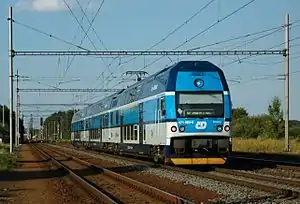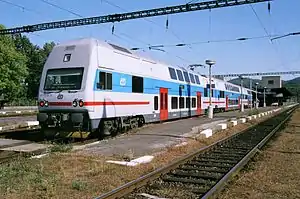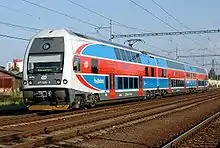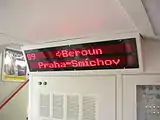ČD Class 471
The Class 471 electric motor unit, commonly known as CityElefant, is a double deck electric multiple unit operating on 3 kV DC overhead wires produced by Škoda Vagonka, a subsidiary of Škoda Transportation, since 1997 and operated by the České dráhy rail transit operator on its suburban services around Prague and Ostrava, Czech Republic. A single unit consists of a Class 471 power car with first class seating, a single Class 071 passenger car and a Class 971 cab car. They are replacement for defunct ČD Class 451. And successor to scrapped ČD Class 470.
| ČD Class 471 CityElefant | |
|---|---|
 | |
| In service | 2000 — present |
| Manufacturer | Škoda Transportation |
| Constructed | 1997 – 2013 |
| Number built | 83 units |
| Number in service | 83 units |
| Capacity | 287 2nd class, 23 1st class |
| Operator(s) | České dráhy |
| Specifications | |
| Maximum speed | 140 km/h (87 mph) |
| Weight | 155.4 tonnes (343,000 lb) |
| Power output | 2,000 kW (2,682 hp) |
| UIC classification | Bo’Bo’+ 2’2’+ 2’2’ |
| Track gauge | 1,435 mm (4 ft 8 1⁄2 in) standard gauge |
Czech railways ordered in total 83 units. The last unit for the Czech Railways was delivered in March 2013. In addition, variants differing in power system and other parameters, have been ordered by Lithuanian Railways, Železničná spoločnosť Slovensko and Ukrainian Railways.
Derived units
Lithuanian Railways
The Lithuanian Railways ordered 13 broad gauge units of class EJ 575. The first train was delivered in 2008 and the last unit was delivered in 2017. They are operated on the route Vilnius - Kaunas since December 2008 and Vilnius - Minsk (Belarus). Units consist of two and three cars. They have very similar interior like Czech class 471. The maximum speed has increased up to 160 km/h (99 mph).
ZSSK
The ZSSK operates 19 units of class 671 and 10 push-pull units of class 951. All of them are three-car units and the maximum speed has increased to 160 km/h (99 mph).
Ukrainian Railways
In January 2011, the Ukrainian Railways ordered two broad gauge units of class EJ 675. Both of them are six-car units. The maximum speed has increased to 160 km/h (99 mph). The units were to be the first trains of a series of 50 to 60 units, however no further purchases were made. They currently operate on the route Kharkiv - Kyiv - Ternopil.
Deutsche Bahn
DB Regio ordered 6 locomotive-hauled push-pull trainsets. Trainsets will be used on Nuremberg–Munich high-speed railway. Push pull units will be hauled by locomotives Škoda 109E. Units are successor of Czech class 471. These new units are designed for speed up to 200 km/h (124 mph). The maximum speed in operation will be limited to 189 km/h (117 mph) as required by Deutsche Bahn in the tender. Trainsets were originally expected to be delivered in 2016, but are still not in service as of February 2020.
Gallery
 The whole unit in Beroun railway station, October 2006
The whole unit in Beroun railway station, October 2006 The whole unit about to arrive Ostrava hlavní nádraží, June 2008
The whole unit about to arrive Ostrava hlavní nádraží, June 2008.jpg.webp) The cab car with new livery
The cab car with new livery The internal information
The internal information The external information
The external information Second class saloon, lower floor
Second class saloon, lower floor Second class saloon, upper floor
Second class saloon, upper floor Second class saloon, mezzanine
Second class saloon, mezzanine.jpg.webp) Stairs
Stairs First class saloon, upper floor of the electric car
First class saloon, upper floor of the electric car Lifting platform for immobile persons
Lifting platform for immobile persons Load compartement with bicycle stand for bicycles
Load compartement with bicycle stand for bicycles
References
- Handl, Erich (January 14, 2008). "Government approves splitting off passenger transport from Czech Railways". Czech Business Weekly. Retrieved 2008-11-08.
Next year, ČD is planning to purchase eight suburban CityElefant train units...
- Hulpachová, Markéta (August 1, 2007), "Hitting the junction. Government greenlights plan to spin off ČD's freight division", www.praguepost.com, The Prague Post, archived from the original on 1 December 2008,
A portion of the loan has been used for the purchase of nine new CityElefant passenger trains for regional transport, replacing the trains’ earlier versions, which have been operating since the 1960s
- "Railway Technology - ŠKODA TRANSPORTATION - Suburban Rail Vehicle Units", www.railway-technology.com, archived from the original on 14 July 2007
- "Drahy will invest in a car fleet". Access Czech Republic Business Bulletin via Europe Intelligence Wire. October 23, 2006. Retrieved 2008-11-08.
External links
| Wikimedia Commons has media related to ČD Class 471. |
- "Suburban EMU CityElefant", www.skoda.cz, SKODA HOLDING a.s., archived from the original on 29 May 2008
- Skulina, Ivan, "Nejmodernější nádražní budova, historická památka a City Elefant", www.cd.cz (in Czech), České dráhy, archived from the original on 26 July 2007
- Zbyněk Zlinský (7 April 2007), "Řídicí vozy na našich kolejích: řada 971", www.vlaky.net (in Czech)
- Rostislav Jančar (5 June 2008), "City Elefant - pantograf, který je lepší než Pendolino", technet.idnes.cz
- Двухэтажный электропоезд для железных дорог Чехии, Железные дороги мира (in Russian) (7), 2000